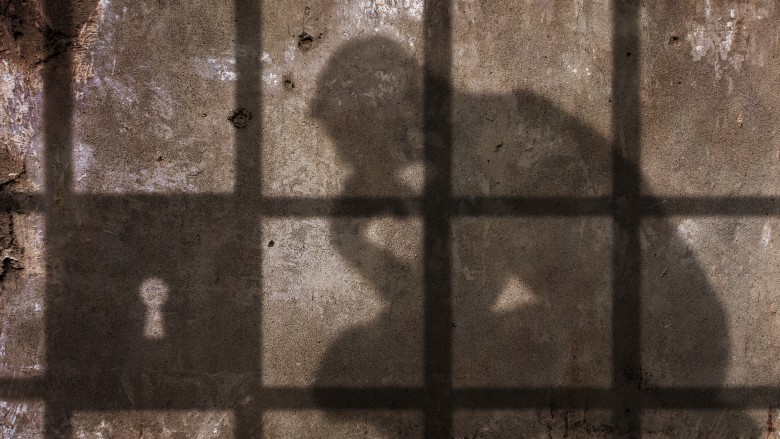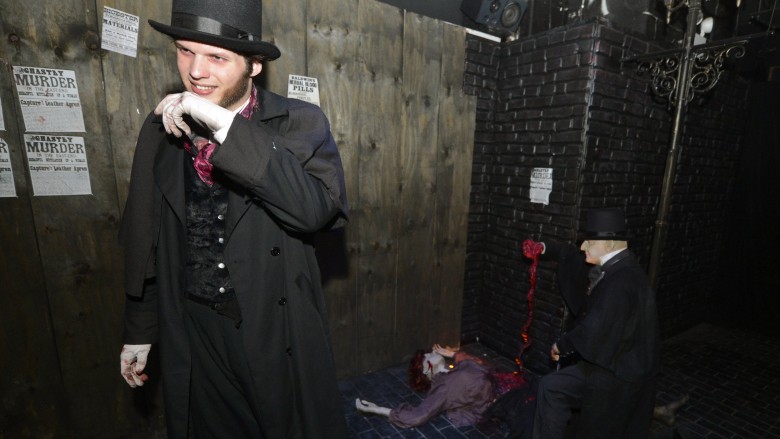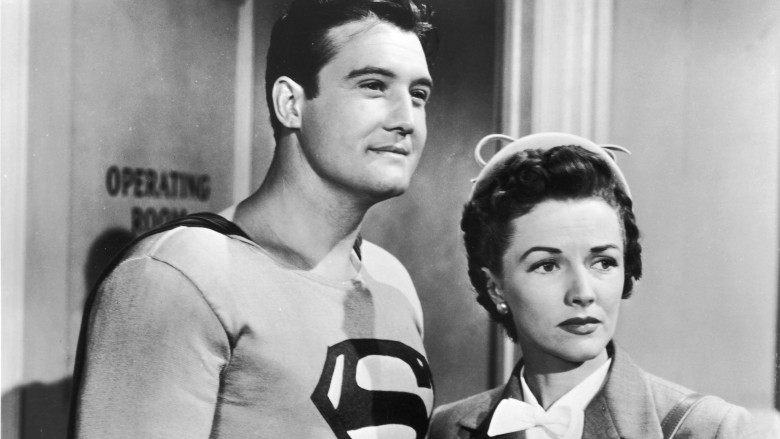True Crime Conspiracy Theories That Keep Us Up At Night
People can't get enough of hearing about crimes like creepy murders and mysterious deaths. Honestly, we can't blame them because it's always so morbidly fascinating. So, if you're done with Serial, wish S-Town had more murders, and Sword and Scale doesn't air new episodes fast enough, here are some true crime conspiracies to add more eerie mystery to your life.
The mystery of room 1046
In 1935, Roland T. Owen checked into Room 1046 at the Hotel President in Kansas City. He had no luggage, and during Owen's stay, the staff noticed odd behavior. The maid for the room always found Owen sitting in darkness, worried. Once, the maid found the door locked from the outside, though Owen had never left the room. Later, she heard two men talking in the room, and when she knocked, a rough-voiced man told her she wasn't needed. A woman in Room 1048 told the police she heard two men and a woman speaking loudly and cursing in Room 1046.
The following morning, a bellhop found Owen on the floor naked, his hands bound, with multiple stab wounds and a fractured skull. Police asked Owen who was with him. "Nobody," he replied. When they asked what happened, Owen said, "I fell against the bathtub." They took him to the hospital, where he died.
The newspaper printed that Owen would be buried in a pauper's grave. That day, the funeral home received a phone call. "Don't bury Owen in a pauper's grave. I want you to bury him in Memorial Park Cemetery. Then he will be near my sister." The man on the phone wouldn't give his name but said he'd pay for the funeral, which he did. The man said Owen had screwed over a girl he was going to marry, so he, the woman, and Owen met up at the President hotel and that "cheaters usually get what's coming to them."
Two years later, the body was identified as Artemus Ogletree, a 17-year-old hitchhiker. His mother hadn't heard from him in over a year, except for three suspicious letters that said he was overseas. The letters were typed, when all his other letters home were handwritten, and they sounded nothing like her son. Eventually, she sent his picture to Kansas City Police, and they confirmed that her son was dead under incredibly mysterious circumstances.
Though it's clear Ogletree spurned some woman and didn't live to tell about it, who the killers were, how they locked him inside the room, and why Ogletree would keep their identities a secret are all unknown. Some people on Reddit argue Ogletree was gay, got caught having a homosexual affair, and was murdered. Regardless, the case is very odd, and since it's over 80 years old, it's unlikely we'll ever know what happened.
The Eriksson twins
A reality TV show was following cops in London when they caught an incredibly bizarre incident on tape, which became the BBC documentary Madness in the Fast Lane. Sabina and Ursula Eriksson darted out onto a busy motorway, seemingly trying to kill themselves. As cops and paramedics pulled the sisters to safety, they fought to be let go and ran out into the highway every time they got a chance. One sister was brutally hit by a car. Though the police thought the accident probably killed her, she got up and ran back into the road. Eventually, the twins were restrained and taken to the hospital as they screamed that someone was trying to take their organs.
Ursula remained in a mental hospital for three months, but Sabina, who acted perfectly normal once she got to the hospital, was released right away. The next day, a man named Glenn Hollinshead saw Sabina on the streets looking troubled, and he offered to help her. He let her stay at his home and said he'd help find her sister. The following morning, she stabbed him five times, and the police found her running through the streets, hitting herself in the head with a hammer. Before she could be detained, she jumped off a bridge.
Somehow, this didn't kill her, and after being hospitalized, she was charged with murder. Experts never found a cause for this sudden insanity, and the case was ruled folie a deux, a rare instance of shared psychosis.
Certainly, this is a weird story and it's been perfect fodder for conspiracy theorists. Some believe the twins were part of the MKUltra experiments, which involved the US government using LSD to control behavior. Others think the sisters were trained super soldiers, due to their strength and imperviousness to severe injury. They claim that the madness only started when the women saw police uniforms, triggering a "self-destruct" program. Others think the case was much simpler: demonic possession. Or alien-human hybrids. Whether they're secret super soldiers or just occasionally crazy twins, this story is incredibly strange and will probably fuel more theories for years to come.
Courtney killed Kurt
Kurt Cobain's suicide has been rife for conspiracy theories since 1994. But Tom Grant gave a bit more legitimacy to the "Courtney Love killed Cobain" theory in the documentary Soaked in Bleach. Grant is a Los Angeles PI who was hired by Love to find Cobain before his suicide. Cobain had mysteriously disappeared from a rehab program just days before completing it, and though Grant was employed by Love, he questioned her motives. Her stories conflicted, and while Grant was on a wild goose chase, Cobain was dead in a room above his garage that Grant was never told about.
Grant states that Cobain couldn't have killed himself. Cobain had just shot up a huge dose of heroin, which should have made him incapable of doing anything, especially putting a shotgun in his mouth. The suicide note is suspect because it seems to contain two different kinds of handwriting, and the part that says goodbye looks as though it were scribbled on in a hurry, possibly by someone else.
Then, you have the Seattle PD. Grant claims the SPD was too quick to rule it a suicide, contaminated and destroyed evidence, and just did a horrible job. The SPD had photos of the crime scene that weren't developed for 20 years, and former SPD police chief Norm Stamper agrees the case was mishandled and should be reopened. Why Stamper didn't reopen the case when he had the authority to do so during his tenure as chief is unknown.
Though Grant speculated that they melted down the shotgun used in the death, the police recently released photos of the gun to prove it was still in police custody. Though that does put a bit of a thorn in the side of Grant's argument, he still maintains that the police were involved in a cover-up and desperately wants the death to be ruled "undetermined" rather than "suicide."
The Sodder Children
In Fayetteville, West Virginia, on Christmas Day 1945, the Sodder house went up in flames. The parents, George and Jennie, and four children escaped, but the five other children never made it out of the house. George tried to reenter the house to save the kids, and he always kept a ladder next to the house, but it was suddenly missing. He tried to drive his truck up to the house to stand on it to reach the second story, but it wouldn't start. By the time the fire department got there, the house was destroyed. The children were assumed dead, though no remains were ever found.
The parents began to think the children might still be alive. A few months before, a strange man tried to sell George insurance. When George turned him down, the man said, "Your goddamn house is going up in smoke and your children are going to be destroyed."
George and Jennie suspected that the reported cause of "faulty wiring" causing the fire couldn't be true, and Jennie couldn't understand how a 45-minute fire could leave no bones but leave appliances mangled but intact. The parents became sure their children weren't dead. It didn't help that people began to claim they'd seen the Sodder children days after the fire.
After hiring private investigators and finding nothing, the Sodders put up a billboard in the early '50s with pictures of their missing children. They found no information till 1968, when Jennie received a letter. It showed a picture of a young man, and on the back was written "Louis Sodder. I love brother Frankie. Ilil Boys. A90132 or 35." The parents thought the picture could be a grownup Louis, but they never received any more information.
George Sodder died in 1968, but Jennie kept holding out hope that someday she'd find her children. Wearing black every day and keeping mostly to her home, she died in 1989, and the missing child billboard came down after nearly 40 years. The only living Sodder child is still searching for her siblings with no new clues.
What really happened with the Friedmans?
Capturing the Friedmans introduced us to the world of the Friedman family and their accusations of child molestation, and also cemented the fact that adult clowns are creepy. Jesse and Arnold Friedman pleaded guilty to abusing children in their computer class, though the only evidence came from statements made by children interrogated for hours who had never made any complaints before. Plus, the judge said that she was sure of Jesse's guilt even before she heard a word of testimony, which is pretty much the opposite of how a judge should act.
Now, Jesse Friedman is out of jail and wants his violent sex offender status removed from his record. He claims he pleaded guilty only because the pair were threatened with life sentences if they went to trial. All of the accusations from the children have been recanted, two dozen witnesses now claim no abuse ever happened, and the key witness Ross Goldstein said his entire testimony was false. So, Friedman wants the state prosecution to disclose all their evidence against him. But they won't do it.
Arnold Friedman did confess to molesting other children and was caught with child pornography, but that still doesn't put any guilt on Jesse. The prosecution's refusal to reveal their evidence is incredibly suspect and could mean there are many chapters left in the sordid Friedman story.
Shelly Miscavige, the disappearing wife
Scientology has come under a lot of scrutiny after the Going Clear documentary and Leah Remini's firsthand account of being a famous Scientologist. One mystery is still looming large: the disappearance of the leader's wife.
L. Ron Hubbard, the sci-fi novelist and alleged wife beater, founded the religion, and David Miscavige became second-in-command. After Hubbard's death, Miscavige assumed leadership, and he and his wife Shelly were the happy faces representing the religion they loved.
Shelly worked under her husband in the church, and many coworkers felt David was more a boss than husband. They slept in separate rooms and showed no public displays of affection. As the Miscavige couple rose to power, David grew meaner. Shelly wasn't particularly kind, though some claim she was merely doing her husband's bidding. In 2006, she made a few company decisions without a direct order from her husband, and she was quickly stripped of all responsibilities and followed by a "watcher." Reportedly, a former Scientologist reached out to Shelly for help, and she replied, "Listen to me. I f***ed up, and I'm not going to be able to help you."
Soon after, Shelly didn't appear in public anymore. If people asked of her whereabouts, they claimed she was on a "special assignment."
Leah Remini, a practicing Scientologist at the time, grew suspicious that for seven years, this notable wife hadn't been seen. After leaving the church, Remini filed a missing person's report, though the police search found nothing. Remini claims Scientology worked with the police to keep Shelly's location, or possible death, a mystery.
Since 2015, anonymous witnesses have claimed to see Shelly in California, looking "frail" and "almost like she was homeless." She was always accompanied by two men. These sightings are only rumors, and the case of the Scientology wife gone missing is still far from clear.
The staircase murder
The documentary The Staircase makes Serial seem like garbage and Making a Murder look like an episode of Barney and Friends. If you want to see a case with tons of twists, turns, and bizarro characters, please check out this Sundance series.
Kathleen Peterson was found dead in her home at the bottom of a staircase. The only other person there was her husband Michael, who was later charged with murder. Michael has insisted on his innocence since day one, though his oddly cocky demeanor, open bisexuality (he slept with other men, apparently with Kathleen's consent), and the fact that another close woman in his life also died via staircase made people question his innocence. But the prosecution used questionable blood spatter evidence and constantly harped on his sexuality as a sign of moral weakness, making the case anything but cut and dry. Peterson was convicted of his wife's murder, but that's not the end of the story.
After the trial, a new theory emerged: An owl killed his wife. This sounds utterly insane, but the talons of an owl would match the lacerations found on her skull, and pine needles and a microscopic feather were found in her hand. They theorize that the wife could have gone out to the front yard and been attacked by an owl (owls are known to dive bomb people if they're threatened in any way). As she went back up the stairs, due to blood loss and blood alcohol levels, she either missed a step or passed out and ended up falling to her death. The theory hasn't been substantiated, but three experts agreed that an owl may have done it after all.
Prince Albert was Jack the Ripper
Jack the Ripper, perhaps the most famous serial killer of all time, has been the target of conspiracy theories for more than a century. Some claim he could have been an anonymous lowlife, while others believe the Ripper may have been a royal. The grandson of Queen Victoria, Prince Albert Edward, known as Eddy, was considered a slow child and described as "self-indulgent" and "listless." At the time, much wasn't made of Eddy, and he died of the flu in 1891.
The Jack the Ripper connection started in earnest in 1970, when Dr. Thomas Stowell pronounced that the Prince was the infamous killer. Using the papers of the royal doctor Sir William Gull as evidence, Stowell claimed Eddy contracted syphilis, went insane, and started killing. The Royal Family knew of his murders, and after they tried to put him away, he escaped again to kill. In the end, he didn't die of flu but of complications of syphilis.
Now, there are quite a few problems with this theory, like Royal Records showing the Prince wasn't in London at the time of some of the murders, but the biggest problem is his source. We'll never know if he really found Gull's papers, since Stowell died just days after publishing his theory and the family burned all his personal papers without reading a word. Maybe the ghost of Eddy came to kill the man who outed him?
Who really killed the first Superman?
Christopher Reeve wasn't the first Superman to die a tragic death. That honor went the George Reeves, TV's Superman of the '50s. Reeves was found naked in his bed with a bullet in his head and a gun at his feet in 1959, and quickly, it was ruled a suicide. But of course, that's not the end of the story.
Reeves very well may have been depressed. He hadn't worked in two years since Superman ended, and he often resented the hero for thwarting his chances for any serious film work. So, some think it really was just a suicide. Or that a car accident from months before left him damaged and high on painkillers, so he decided to end his life. The visitors at his home that night all told police that it was definitely an act of self-harm. Some of them didn't know Reeves at all, but that didn't seem to make a difference.
His girlfriend, Leonore Lemmon, who was present that night with a few friends, originally said she knew he was going to kill himself. Earlier that night, he came downstairs to the partiers in a bad mood, and as soon as he left, she knew he was getting his gun. When police asked why she didn't try to stop him, Lemmon changed her tune a bit. She claimed she didn't really say that he was going to kill himself. The cops still considered it a suicide, so they didn't dust for fingerprints, check for gun residue, or see if it was physically possible for Reeves to have killed himself. They didn't need to since a suicide ruling meant the bedroom wasn't technically a crime scene.
Toni Mannix—ex-lover of Reeves, current wife of Eddie Mannix, and notorious "fixer" at MGM—was another suspect in his death. Phyllis Coates, Lois Lane from the show, received a call from Toni Mannix early the morning of Reeves's death. She frantically told Coates that Reeves had been killed, though how Mannix could have known so early seemed very suspicious. Also, that gun at his feet? That was registered to Eddie Mannix.
So, whether it was the doing of a drunken girlfriend, an angry ex, a furious cuckolded husband, or a suicide, we'll probably never know the real kryptonite for the first Superman.









